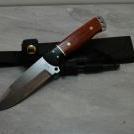-
Posts
412 -
Joined
-
Last visited
About ChuckBurrows
- Birthday 01/08/1953
Contact Methods
-
Website URL
http://www.wrtcleather.com
Profile Information
-
Gender
Male
-
Location
Durango, CO
LW Info
-
Leatherwork Specialty
Frontier Leather and Knives
Recent Profile Visitors
16,833 profile views
ChuckBurrows's Achievements

Member (2/4)
-
You're welcome Dwight and yes I'm one of those that when told you CAN'T do something just has to try... part of this of course is being able to accept failure, albeit I don't think of my unsuccessful experiments as being failures, but like Edison, I just figure that I found ways NOT to do something (a paraphrase of his comments on his experiments with light bulbs)
-
Perhaps oddly but one I have used 70% rubbing/isopropyl alcohol as a thinner for over 50 years and it's 30% water, plus I have mixed some homemade water based dyes (walnut is one) with spirit dyes for years as well, and I ALWAYS water dampen my leather all the way through when dying. Not a recommendation but based on my experience it can work, but then again I generally practice on a scrap of the same leather since every hide and bottle of dye can vary to a degree. As always others mileage will vary.....
-

Do All Chrome-Tanned Leathers Not Age?
ChuckBurrows replied to Acceptable's topic in Leatherwork Conversation
Look for naked or pull-up chrome tan - these are the best types to get age on them - whether artificially induced or with time and wear. Take a look at the chaps and botas on my website - most are chrome tanned and you can see how well they aged www.wrtcleather.com -
In the old days it was generally called blacking or harness blacking and sometimes vinegar blacking to differentiate between it and other blacking compounds that used other material like lamp black and logwood.
-

Deer Fat For Tallow
ChuckBurrows replied to gamli's topic in Dyes, Antiques, Stains, Glues, Waxes, Finishes and Conditioners.
gamli - I only add oil if the wax/tallow is to stiff. I want it fairly stiff, but soft and creamy enough to spread well without pre-heating although that doesn't hurt to melt and apply warm. -
Well for the last 50 years I've used everything from 200 year old wrought and cast iron as well as cans of old rusty nails and steel wool, both de-oiled and not, and FWIW I've never found a spits worth of difference no matter the material, except the rusty iron might give a reddish cast (especially on maple wood, but on leather always black). Sure you don't want to use stainless or some such, but IMO any iron/steel that will rust works just fine.
-

How Do You Prevent Too Many Orders If You Work Alone?
ChuckBurrows replied to Tallbald's topic in Marketing and Advertising
Having been in the same situation (at one time I as 5 years back ordered) raising prices and limiting your offereingscan help, but what I and most of my colleagues in the same boat do is make a list of customer requests. Let them know approximate start/finish time and if they choose to be on the list then when their name comes up you make contact. If they choose to order I took (no longer taking orders due to health reasons) a small down payment once I started. If for whatever reason they could not order when their name came up I either offer to put them at the bottom of the list or if they choose to remove their names. -

Will Nickel Silver Create Green Waxy Build-Up?
ChuckBurrows replied to timesofplenty's topic in Leatherwork Conversation
s others noted it's not just the metal but whether moisture is part of the problem. While GS aka nickel silver contains a lot of copper, it generally does NOT form verdigris like copper or brass due to the nickel content. That statement is based on 50 years of using German Silver. -

Is This Correct? Chrome Vs Vegetable Tanning
ChuckBurrows replied to Sarden's topic in Leatherwork Conversation
FWIW - anyone who thinks large scale or even small scale veg tanning is "natural" needs to talk tot he folks at the tanneries and found out how fun it is to deal with the EPA and having to update their tooling and methods causing many in the USA to close their doors forever. Yes tannins are "natural" but that doesn't mean they are good for the environment especially on an industrial scale. Read the history and you will find most tanneries were situated from the public when possible due to the odor and rivers and streams were so heavily polluted that the fish were killed off. Even in a natural setting such as a cedar swamp the water can become so bad due to the tannic acids that critters, even most bugs, can't live off it - drink some and you will think you sucked in a lemon. And FWIW - chrome tan (albeit in many countries chrome tannin is and has been being phased out by using aldehydes rather than chrome salts) can take on an awesome patina when it's full grain, pullup is just one type of chrome tan full grain that gets an awesome patina over time and is often used on very high end furniture and for high end car seats. And while seeking out natural products is generally a good thing and admirable, but please be aware that tanning is only one part of the process, and when it comes to the butchering, dehairing, removal of flesh, etc. are common all types of tanning (veg, chrome, brain, oil, etc.) and produce thousands of pounds of industrial waste, so tanning on any level is all that "natural" when it comes to possible damage to the environment. FWIW - in over 50 years of running my own leather business and also being a small business adviser for 35 years I found the number one thing is to be honest. And as noted above their is some not so good info out there one glaring example is one of the leather waterproofing sites, which states oils are bad for leather since all oils are eliminated during the tanning process which is true, BUT oils, fats, etc. are re-introduced during the currying stage, the stage where the leather is thinned/split, top finished if need be, dyed, oiled, softened, etc.- 26 replies
-
- vegetable tan
- chrome tan
-
(and 1 more)
Tagged with:
-

My Sheath Caused Pitting On A Customers Knife
ChuckBurrows replied to Eric Pikey's topic in Leatherwork Conversation
Many EXPERIENCED makers use 0 1 for a blade because it makes an excellent one and is much easier to harden without specialized equipment. Non-corrosive steels are used by many but 95% of the pro chefs I've made knives for, much prefer plain non-stainless for use. Hi-carbon non-stainless knives are extremely popular for many other reasons as well. For instance I make only high end historically inspired knives mostly from the early 1800's and using anything but a non-stainless such as 1084 (my favorite and the closest modern steel to those used in the past) or 01 would be wrong, especially for my customer base who are sticklers for keeping things as authentic as possible. Plus I've made around 3,000 sheaths for OTC hi-carbon hunting knives, including the classics such as Marbles and the older German knives and done right they've never caused a problem as long as the customer treats the pair properly (like not leaving it in the sheath covered in blood). -

My Sheath Caused Pitting On A Customers Knife
ChuckBurrows replied to Eric Pikey's topic in Leatherwork Conversation
I'd agree with Art (and FWIW I'm a custom knife maker as well as leather crafter and have been since 1971). 1) O 1 steel is infamous for staining and eventually pitting if not properly cared for. 2) Even nitric won't cause pits that fast One suggestion - if you're going to dye the inside finish it as well with a good acrylic type finish before assembly - even plain veg tan (at a PH of 4.5-5, neutral is making even veg tan acidic) can cause staining pitting especially when wet - -

Dye/stains For Chrome Tanned Leathers
ChuckBurrows replied to backtobasic's topic in How Do I Do That?
Guess some folks haven't used much chrome tan since it takes most any of the spirit based dyes well. While it reacts a bit differently than on veg tan it works just fine. Been dying and over dying (darker over a pre-dyed hide) chrome tan since the 1970's. And yep it will take aging well although a bit harder to do aging with it rather than veg tan, You can see aging of chrome tan on some of the chaps and botas I've built using it: http://www.wrtcleather.com/Chaps/index-gallery.html http://www.wrtcleather.com/Botas/slides/Botas_002-1.html






